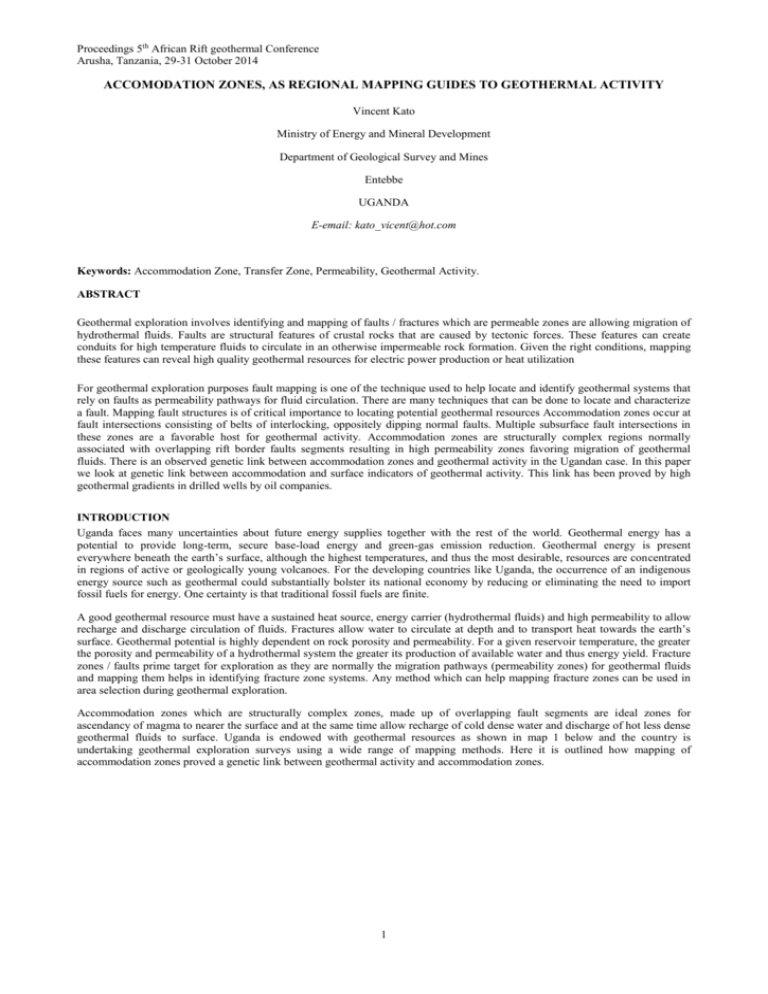Full Paper template (ARGeo-C5)
advertisement

Proceedings 5th African Rift geothermal Conference Arusha, Tanzania, 29-31 October 2014 ACCOMODATION ZONES, AS REGIONAL MAPPING GUIDES TO GEOTHERMAL ACTIVITY Vincent Kato Ministry of Energy and Mineral Development Department of Geological Survey and Mines Entebbe UGANDA E-email: kato_vicent@hot.com Keywords: Accommodation Zone, Transfer Zone, Permeability, Geothermal Activity. ABSTRACT Geothermal exploration involves identifying and mapping of faults / fractures which are permeable zones are allowing migration of hydrothermal fluids. Faults are structural features of crustal rocks that are caused by tectonic forces. These features can create conduits for high temperature fluids to circulate in an otherwise impermeable rock formation. Given the right conditions, mapping these features can reveal high quality geothermal resources for electric power production or heat utilization For geothermal exploration purposes fault mapping is one of the technique used to help locate and identify geothermal systems that rely on faults as permeability pathways for fluid circulation. There are many techniques that can be done to locate and characterize a fault. Mapping fault structures is of critical importance to locating potential geothermal resources Accommodation zones occur at fault intersections consisting of belts of interlocking, oppositely dipping normal faults. Multiple subsurface fault intersections in these zones are a favorable host for geothermal activity. Accommodation zones are structurally complex regions normally associated with overlapping rift border faults segments resulting in high permeability zones favoring migration of geothermal fluids. There is an observed genetic link between accommodation zones and geothermal activity in the Ugandan case. In this paper we look at genetic link between accommodation and surface indicators of geothermal activity. This link has been proved by high geothermal gradients in drilled wells by oil companies. INTRODUCTION Uganda faces many uncertainties about future energy supplies together with the rest of the world. Geothermal energy has a potential to provide long-term, secure base-load energy and green-gas emission reduction. Geothermal energy is present everywhere beneath the earth’s surface, although the highest temperatures, and thus the most desirable, resources are concentrated in regions of active or geologically young volcanoes. For the developing countries like Uganda, the occurrence of an indigenous energy source such as geothermal could substantially bolster its national economy by reducing or eliminating the need to import fossil fuels for energy. One certainty is that traditional fossil fuels are finite. A good geothermal resource must have a sustained heat source, energy carrier (hydrothermal fluids) and high permeability to allow recharge and discharge circulation of fluids. Fractures allow water to circulate at depth and to transport heat towards the earth’s surface. Geothermal potential is highly dependent on rock porosity and permeability. For a given reservoir temperature, the greater the porosity and permeability of a hydrothermal system the greater its production of available water and thus energy yield. Fracture zones / faults prime target for exploration as they are normally the migration pathways (permeability zones) for geothermal fluids and mapping them helps in identifying fracture zone systems. Any method which can help mapping fracture zones can be used in area selection during geothermal exploration. Accommodation zones which are structurally complex zones, made up of overlapping fault segments are ideal zones for ascendancy of magma to nearer the surface and at the same time allow recharge of cold dense water and discharge of hot less dense geothermal fluids to surface. Uganda is endowed with geothermal resources as shown in map 1 below and the country is undertaking geothermal exploration surveys using a wide range of mapping methods. Here it is outlined how mapping of accommodation zones proved a genetic link between geothermal activity and accommodation zones. 1 [Type text] Map-1: Showing geothermal prospects in Uganda THEORY OF ACCOMMODATION ZONE. Accommodation zones occur at fault intersections consisting of belts of interlocking, oppositely dipping normal faults. Multiple subsurface fault intersections in these zones are a favorable host for geothermal activity. Accommodation zones are long term critically stressed zones, where geothermal fluid path way are more likely to remain open in networks of closely spaced, breccia dominated fractures. Diagram: Diagrammatic representation of accommodation zones. 2 List Authors in Header, surnames only, e.g. Smith and Tanaka, or Jones et al. Diagram: Typical Examples of accommodation zones. Figure. Fault initiation stages and propagation to link up into a single main fault. ACCOMODATION ZONES IN THE ALBERTINE GRABEN There are several identified and mapped accommodation (transfer) zones in the Albertine graben (see map-2) but what should not escape notice in the spatial relationship between these zones, surface geothermal activity and oil deposits. These are pronounced transfer zones in the Albertine Graben, both accommodation zones and relay ramps. These zones experienced considerable lateral stretching and thinning of the crust. This could have led to higher heat flow in the area. Due to relative displacement on the two linking major faults, complex structuring and thinning develops in the accommodation zones. In the Albertine Graben, however, the amplitude of the structures, especially in the hanging wall, indicate that there could be an element of lateral movement along strike ((Dozith Abeinomugisha et al). The structural elements in the northern domain return to a NNE- SSW trend. These structural domains are separated by accommodation zones (Dozith Abeinomugisha et al). 3 [Type text] Figure. Map-2 showing the structural elements in the Albertine Graben (PEPD). PANYIMUR ACCOMODATION ZONE Petroleum Exploration and Production Department (PEPD) mapped accommodation zones in Panyimur geothermal area and these are ideal places for geothermal activity. At Panyimur, highly faulted accommodation zone coupled with a change in fault trend from NE-SW to an almost N-S trend created rotated fault blocks that area ideal for geothermal activity. At the northern tip of Lake Albert, the NE-SW faults die and switch to a N-S trend in the Pakwach Basin (see map 3) before changing polarity into Rhino Camp Basin. Map-3 shows various faults dying out with others taking over through relay structures (or transfer faults). Because in the EARS, extension is still low as the rift is still evolving, the accommodation zones are topographic highs (e.g. Morley et al., 1990). This is the case within the Albertine Graben in which such highs act as sediment sources to the sub-basins. Fluvial systems have directed sediment accumulations in the Pakwach Basin as a result of this accommodation zone and consequently excellent reservoirs in the area are accounting for more than 800 MBO in place for the already discovered resources (Dozith Abeinomugisha et al). Map3: Digital elevation model map showing the transfer zone between the Pakwach Basin and the Rhino Camp Basin (PEPD). The Pakwach Basin which itself is a transfer zone from the Lake Albert Basin to Rhino Camp Basin. Panyimur area is an extensional domain (highly extended crust). Volcanism is not a major factor as no volcanic rocks are exposed. Panyimur is a region of warm crust and the crust is pulling apart or extending (extensional tectonism). As crust thins, hot rocks get closer to surface hence potential for geothermal activity. Major Basin Bounding deep faults allow hot water to reach shallow levels. At the northeastern end of the Albert Basin, the Pakwach sub-basin deviates from the northeasterly trend of the Albert Basin (map-4) to a more northerly heading. Recent seismic surveys (by oil companies) within this area demonstrate that within this sub-basin the structures exhibit a more extensional character with normal fault-bounded blocks being the dominant structural target for the area. The combination of structural styles seen in the Albert Basin and the Pakwach Sub-basin suggests a sinistral sense of strike-slip movement along the axis of the Albert Basin. Fracture permeability accentuated on fault segments; here accommodation zones are critically stressed under ambient stress conditions and accommodation zones have fault tips and fault intersections where stress concentrations produce and maintain dense fracture networks. Geothermal 'fairway' of high fracture permeability and fluid flow where collocation of critically stressed fault segments, and high fault intersection density . 4 List Authors in Header, surnames only, e.g. Smith and Tanaka, or Jones et al. Map 4: Geology map of the area (DGSM). Note the highly fractured structural high (Accommodation zone) In Panyimur Geothermal Area, these are loci of strain transfer, regions of high strain rate. Pakwach Accommodation zone is also called Waldelai Accommodation zone (High fault intersection density) . The Northern Domain has a trend of NNE-SSW and is asymmetrical. Waldelai Accomodation zone in Pakwach Basin is controlled by Panyimur Fault on the Western Side. The Basin is made of half graben and rotated fault blocks. The area display purely extension tectonics, with one major basin bounding fault and a ramping opposing flexural margin. Fault systems are highly segmented along strike, Map 5: Up-dated geology map of the area showing hot springs and diatomite deposits (DGSM). While accommodation zones have a role to play in existence of geothermal activity, they area also prospective areas for oil exploration as they form ideal oil traps and also the high geothermal gradient and heat flow contributes to oil maturation. North of the Victoria-Nile, the most significant discovery so far was made at the Jobi-1 and Rii-1, drilled at the end of 2008. These wells intersected the same large oil accumulation. Figure: Ondyek Well Temperature versus depth (m) 5 [Type text] According to data, the rate at which the temperature increases (geothermal gradient or temperature gradient) is high and hence a high geothermal gradient prevail in this area. Thus this is a zone of higher than average heat flow and is most likely to encounter high temperature at shallow depth, perhaps shallower enough to favor exploitation of geothermal energy. Figure: Riwu Well Temperature versus depth (m) According to data, at 1,000m, is likely to be high. This is again anomalous values in rocks of low thermal conductivity, slow heat transfer and high thermal gradients. These are areas of high heat flow and high geothermal gradient. Ground water circulates deeply along the major fault zones that bound blocks of the highly extended crust of the region. This ground water simply is heated as it circulates downward within the zones of fractured and therefore permeable rock. KAISO-TONYA ACCOMODATION ZONE Kaiso-Tonya area has surface geothermal features which include diatomite occurences along River Sebugoro, gypsum flakes, bentonite beds and hydrothermally altered ground. More focused studies are recommended in this area to study the hypothesized relationship between diatomite occurrence and geothermal activity. Geothermal activity here could have played a role in maturation of oil which has been discovered in this area. Figure: Mputa Well temperature degrees centigrade versus depth (m) According to the figures above, this area has a high geothermal gradient and high heat flow. Figure: Nzizi Well temperature versus depth (m) According to the data, Nzizi geothermal gradient is still anomalous. 6 List Authors in Header, surnames only, e.g. Smith and Tanaka, or Jones et al. Figure: Waraga Well Temperature versus depth (m) According to the data obtained from the drill wells, at 1000m, this is anomalous but not as high as that of Nziz and Mputa. One has to note a trend towards a high anomalous area. Low conductivity rocks lead to high thermal gradient and vice versa. SEMULIKI ACCOMODATION ZONE This Accommodation zone is also associated with surface geothermal activity. Surface geothermal indicators include travertine, gypsum flakes, gaseous emission, bubbling hot springs and geothermal grass. Like the previous accommodation zones, this one is linked to oil deposits as well. Turaco well were drilled along Makondo faults which is having surface geothermal indicators. Map: Showing change in fault directions at accommodation zones. Figure: Turaco Well Temperature versus depth (m) According to the data, high geothermal gradient prevail at 1000m. KATWE-KIKORONGO ACCOMODATION ZONE This accommodation zone is also linked to surface indication of geothermal activity (see map below). It is located in a tectonically active area with geologically young vulcanicity. The little-eroded shapes of explosion craters indicate geologic youth. Surface geothermal indicators include hot springs, warm springs, seeps, travertine, salt precipitates, fumaroles, geothermal grass, gaseous emissions, and volcanic craters. This accommodation zones is also associated with high geothermal gradients as evidenced from drilled holes (see figure below). 7 [Type text] Map: accommodation is related to volcanic crater field Figure: Ngaji Temperature versus depth (m) According to data, the area has high temperature gradient and hence a high geothermal gradient prevail at just 1,000m. OTHER ACCOMODATION ZONES Since a genetic link has been observed between accommodation zones and geothermal activity, other identified accommodation (map below) zones should be mapped to look for surface indicators of geothermal activity. Map: Showing accomodation zones (PEPD). CONCLUSION Accommodation zones are areas of high dilation tendency and high fault intersection densities which are ideal plays for 8 List Authors in Header, surnames only, e.g. Smith and Tanaka, or Jones et al. geothermal activity due to prevalent high heat flow. These are prime targets for the discovery and development of geothermal. At Panyimur major structural features have been formed in transfer zones along major rift bounding faults. These highly faulted accommodation zones (structural highs) coupled with a change in fault trend from NE-SW to almost a N-S trend created rotated fault blocks that have a potential for geothermal activity. Here hot molten magma comes nearer to surface at shallow levels and also allow migration of hydrothermal fluids and recharging fluids. Some of these structures have been drilled and found to have significant amounts of hydrocarbons but at their periphery would be geothermal activity as evidenced by surface indicators of geothermal activity (bubbling hot springs). Geothermal activity has also been proved by drilled oil wells around these accommodation zones. Understanding the role of transfer zones (Accommodation zone) in the formation of geothermal resources is essential for future geothermal exploration efforts. Accommodation zones are prime targets for the discovery and development of geothermal resources. REFERENCES Abeinomugisha, D., et al., Report on Geological Mapping of Butiaba-Wanseko area: unpublished report, (2006) PEPD. Abeinomugisha et al. Transfer Zones and Hydrocarbon Accumulation in the Albertine Graben of the East African Rift System (2006) Daly, M.C., J. Chorowicz, D. Fairhead, Rift basin evolution in Africa: the influence of reactivated steep basement shear zones (1989), M.A. Cooper and G.D. Williams, (eds.), Inversion Tectonics, Geological Society of London Special Publication, v. 44, p. 309-334 (1990) Morley, C.K., R.A. Nelson, T.L. Patton, and S.G. Munn, Transfer zones in the East African Rift System and their relevance to the hydrocarbon exploration in rifts: American Association of Petroleum Geologists Bulletin, v. 74/8, p. 1234-1253 (1990). Morley, C.K., Patterns of displacement along large normal faults: Implications for basin evolution and fault propagation based on examples from East Africa: AAPG Bulletin, v. 83, p. 614-634 (1999). 9





